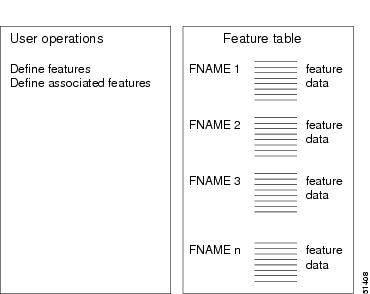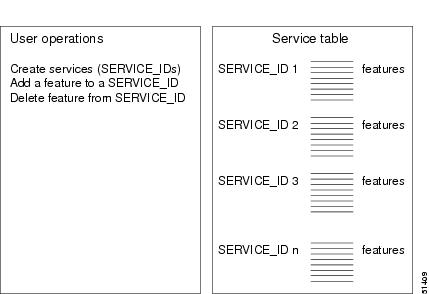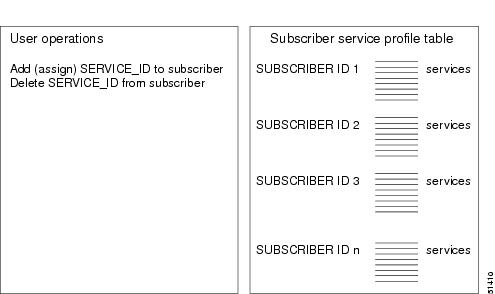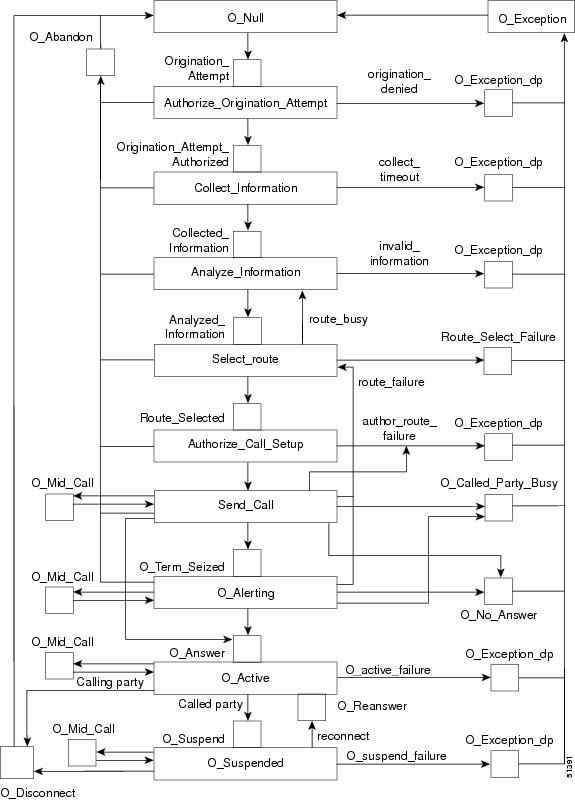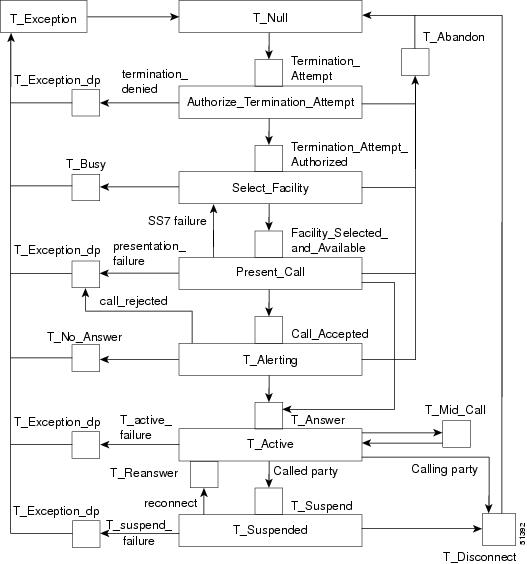

Table Of Contents
Overview of Features and Services
Creation of Features and Services
Trigger Detection Points, Trigger IDs, and Call States
CHD, CFNA, and CW Interaction for Centrex Subscriber
Calling Number Delivery Interaction
Feature Interactions
Revised: July 2, 2009, OL-7680-24This chapter describes the interactions among the various features offered by the Cisco BTS 10200 Softswitch. It includes the following topics:
•
Overview of Features and Services
•
Creation of Features and Services
•
Trigger Detection Points, Trigger IDs, and Call States
•
Special Interaction Scenarios
Service providers define the features and services for their system, and assign these services to subscribers. A service is a collection of features. Each feature has static information, stored in the feature table, regarding triggers, feature defaults, associated features, and vertical service codes. When a service is created, the system automatically maps the service with the triggers. The system uses internal information about triggers and trigger detection points (TDPs), based on the ITU-T CS-2 call model, to process features during a call. The system has internal information to handle features that interact with other features at specific detection points. The system also handles features that are inhibited when certain other features are already invoked on the subscriber line.
Note
See Chapter 1, "Network Features" and Chapter 2, "Subscriber Features" for detailed descriptions of individual features.
Note
Some features involve the use of other network elements (NEs) deployed in the service provider network, for example, gateways, media servers, announcement servers, eMTAs, and SIP phones. See the Component Interoperability section of the Release Notes for a complete list of the specific peripheral platforms, functions, and software loads that have been used in system testing for interoperability with the Cisco BTS 10200 Softswitch Release 4.5.x software. Earlier or later releases of platform software might be interoperable and it might be possible to use other functions on these platforms. That list certifies only that the required interoperation of these platforms, the functions listed, and the protocols listed have been successfully tested with the Cisco BTS 10200 Softswitch.
Overview of Features and Services
Service providers use command-line interface (CLI) commands to provision the features and services for their system. The feature table contains all the static information for a feature, such as:
•
Trigger detection point (TDP)
•
Trigger ID (TID)
•
Trigger type
•
Vertical service code, if any
•
Feature Server
•
Feature defaults
•
Associated features, if any (for example, CFU_ACT and CFU_DEACT can be associated with CFU)
A service is a collection of one or more features (up to 10 features per service). Each service is identified by a unique service ID numeric value. Each feature within a service may have one or more triggers. When a service is created, the system automatically registers the triggers. During call processing, the services are triggered based on TDP and TID. The Cisco BTS 10200 Softswitch supports provisioning of up to 50 services per subscriber.
Note
Limitation—If services are defined (by the service provider) such that they share the same TDP-TID pair, the Cisco BTS 10200 Softswitch supports a maximum of 10 services for that TDP-TID pair.
Creation of Features and Services
Figure 4-1 through Figure 4-3 show the process of creating features, assembling features into services, and assigning services to individual subscribers (or subscriber groups). The provisioning operations listed in these figures are performed using CLI commands. Feature provisioning steps are provided in the Cisco BTS 10200 Softswitch Provisioning Guide. Detailed reference information on commands and parameters (tokens) is provided in the Cisco BTS 10200 Softswitch Command Line Interface Reference Guide.
Figure 4-1 Defining Features and Associated Features
Note
Associated features, such as CFU_ACT and CFU_DEACT, must be defined first, and then they can be linked (associated) with the main feature (CFU in this case).
Figure 4-2 Assigning Features to Services
Figure 4-3 Assigning Services to Subscribers
Trigger Detection Points, Trigger IDs, and Call States
The call states and triggers for the Cisco BTS 10200 Softswitch are illustrated in Figure 4-4 and Figure 4-5.
Note
The basic call module of the Cisco BTS 10200 Softswitch contains the triggers specified in the standard ITU-T CS-2 call model, as well as several additional triggers.
For illustration purposes, Table 4-1 lists several examples of TDPs and TIDs for some features.
Note
For a complete list of TDPs and TIDs for all features, see the appendix of the Cisco BTS 10200 Softswitch Command Line Interface Reference Guide.
Figure 4-4 Cisco BTS 10200 Softswitch Originating Call States and Triggers
Figure 4-5 Cisco BTS 10200 Softswitch Terminating Call States and Triggers
Feature Precedence
If the call processing function in the CA detects a TDP, it sends a trigger, if applicable, to the appropriate Feature Server (FS). After receiving the trigger, the FS controls the call as needed. With multiple features assigned to a single service package, it is possible for more than one feature to trigger at the same TDP. When that occurs, the Cisco BTS 10200 Softswitch uses the feature precedence table (Table 4-2), along with the subscription information of the subscriber, to determine which feature to provide. If multiple features are included in a service package (as they often are), it is important for the service provider to be able to identify to their subscribers which feature takes precedence at a particular TDP. The TDPs for each feature, and the precedence conditions for specific feature pairs, are defined in the system and cannot be changed. The precedence functionality is implemented in accordance with the LSSGR specification.
Note
See the Cisco BTS 10200 Softswitch Command Line Interface Reference Guide, service-trigger table, for additional information about triggers for multiple features that are grouped into a service package.
Tip
As shown in Figure 4-4 and Figure 4-5, a call reaches TDPs in a specified sequence consistent with the CS-2 call model. A feature triggered at an earlier TDP is not said to have precedence over a feature triggered at a later TDP. Precedence refers to a scenario in which two features occur at the same TDP, and the Cisco BTS 10200 Softswitch uses internally programmed rules to determine which feature takes precedence at that TDP.
Table 4-2 Feature Precedence
1
TERMINATION_
ATTEMPT_AUTHORIZED•
SCR has priority over:
SCF
DRCW
SCA
ACR
CFU
DND
MDN
DACWI
•
ISFG has priority over CFU
•
SCF has priority over:
DRCW
SCA
ACR
CFU
DND
MDN
DACWI
•
DRCW has priority over:
•
SCA has priority over:
ACR
CFU
DND
MDN
DACWI
DRCW
•
ACR has priority over:
CFU 1
DND
MDN
DACWI
•
CFU has priority over:
DND
MDN
DACWI
•
DND has priority over:
MDN
DACWI
•
MDN has priority over:
DACWI
2
FACILITY_SELECTED
_AND_AVAILABLE•
CNAM has priority over CND
(CNAM includes CND. If a subscriber has both features, CNAM is provided.)
3
T_BUSY
•
CIDCW has priority over:
CW
CFB
•
CW has priority over CFB
4
O_ATTEMPT_AUTHORIZED
•
HOTLINE has priority over WARMLINE
5
COLLECTED_INFORMATION
•
CDP and VSC are independent features, with different triggers
•
CDP has priority over COS
•
Call agent does not report COS trigger for VSC dialed
6
O_MIDCALL
and
T_MIDCALL•
CT has priority over:
TWC
TWCD
1 If all three features (DRCW, ACR, and CFU) are assigned to a subscriber, CFU takes precedence over ACR and DRCW.
Feature Inhibition
Feature inhibition is defined as an interaction where the subscriber's current feature status inhibits other features from being provided. The inhibition functionality is implemented in accordance with the LSSGR specification. This table is preset in the system and cannot be modified. Table 4-3 shows how features are inhibited by various other features.
Tip
If a call is released at a particular TDP, the later TDPs will not be reached, and the features associated with those later TDPs will not occur. This is a direct result of the TDP sequencing, and is not defined as inhibition. Feature inhibition occurs when a trigger is reached, but one of the features associated with the TDP has been inhibited by a feature that occurred at an earlier TDP.
Note
MDC refers to midcall, which is a function activated when the user presses the Flash button or hookswitch during a call. In Table 4-3, MDC is treated as an internal feature, with the following meaning:
Certain features inhibit MDC. This means that when one of those features is invoked, the Cisco BTS 10200 Softswitch ignores the Flash and hookswitch functions.
MDC inhibits several features. This means that those features cannot be supplied to the user after the user presses the Flash button or hookswitch.
Special Interaction Scenarios
This section describes additional interaction scenarios.
DND and CFB Interaction
If a called party (subscriber) is assigned both the DND and CFB features, and has activated them, an incoming call will be forwarded to the CFB forward-to DN whether the called party is busy or not.
CHD, CFNA, and CW Interaction for Centrex Subscriber
There is an interaction when a Centrex subscriber has all three of the following features assigned and active:
1.
Call hold—CHD.
2.
Call waiting—CW or CIDCW or both.
3.
Call forwarding on no answer—CFNA, VM (or VMA), or any combination of these.
In this case, the system does not invoke forwarding for any incoming calls. If the subscriber wants to have the call-waiting features (CW or CIDCW) and call-forwarding features (CFNA, VM, or VMA) active simultaneously, the service provider should not assign the CHD feature to that subscriber. For additional clarification, see the "Feature Interactions with CHD" section on page 2-60.
Examples of Interactions
Feature interaction examples are presented in this section for the following scenarios:
•
Three-way calling
•
Call waiting
•
Calling number delivery
Three-Way Call Interaction
The following interactions pertain to three-way calling (TWC):
•
TWC can interact with itself. Given three parties involved in a call, any party with the TWC feature who has not already added can flash and add on another party. In other words, TWC can be recursively used to join more than three parties.
•
A customer who has initiated TWC cannot initiate TWC again while in a TWC conference call.
•
The use of TWC does not restrict the call waiting capabilities of the customers who did not initiate TWC.
•
The initiator of TWC does not receive CW calls or the CW tone while in a TWC mode or while a party is on hold.
•
When a line that is not the initiator of TWC receives a CW call, a flash is not interpreted as a request for TWC (that is, CW takes precedence over TWC in this case).
•
TWC can be used to disable CW during an existing conversation.
•
When CW is in effect, it takes precedence over TWC. When CW is disabled, TWC treatment is given when the customer flashes.
•
If a customer activates cancel call waiting (CCW) and then originates TWC, CW remains disabled until all connections are torn down. If either of the noncontrolling parties of TWC disconnect (or are disconnected by the controller), CW remains disabled for the remaining two-way connection.
•
If the initiator of TWC hangs up with a party on hold, the initiator will be rung back and connected to the held party on answer. If the initiator's CW was disabled prior to hanging up on the held party, it remains disabled after the customer answers the ringback.
•
Flashes are ignored after a two-way call has been set up to a 911 attendant. This means that for the duration of the 911 call, the TWC feature cannot be used.
•
A customer involved in a two-way call can flash and use TWC to add-on a 911 attendant. All subsequent flashes will be ignored.
Call Waiting Interaction
The following interactions pertain to call waiting (CW):
•
If a line has call forwarding on busy (CFB) and CW, the CW service normally takes precedence over CFB.
•
Given a line that has both CFB and CW and is in a talk state, the first call attempting to terminate is treated as a CW call. Subsequent termination attempts will be call forwarded (that is, CFB is invoked only if a call is already waiting).
•
If CW treatment cannot be given (for example, because the line is dialing or ringing), then CFB takes effect.
•
CW and CCW cannot be invoked simultaneously.
•
When CW is disabled via CCW, it only applies to calls terminating at the subscriber line. It does not affect calls terminating at other subscriber lines.
•
During a call to a 911 attendant, the CW service is inhibited (that is, no CW tone).
Calling Number Delivery Interaction
The following interactions pertain to the calling number delivery (CND) feature:
•
No CND data is sent during or after a CW tone.
•
CND data is sent for held and waited parties during the first silent interval of ringback that results from the customer going on hook in response to a CW tone.

 Feedback
Feedback
